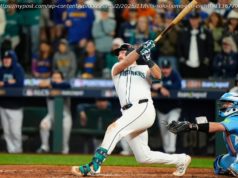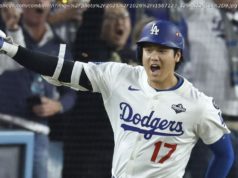Despite the limited innings starting pitchers are used in the current era of postseason competition, the starters who provide the most quality innings between the Dodgers and Red Sox will be the deciding factor on which club wins the World Series.
Red Sox left-handed starter Chris Sale could be a huge factor in the success of Boston’s quest for a World Series title. (AP Photo/Steven Senne)
Postseason baseball is a different animal today that it was in years past when starting pitchers like Bob Gibson, Sandy Koufax, Whitey Ford, Randy Johnson, John Smoltz, or Greg Maddux controlled the game. Today, it’s a chess match between managers guiding clubs that are no longer stacked with reliable starting pitchers. In many games, managers remove starters in a close game to either use a pinch hitter or when strategy dictates a pitching move.
In the 2018 National League Championship Series, the Dodgers defeated the Milwaukee Brewers in a seven-game match that saw a combined 70 pitching changes, 161 strikeouts, 2,072 pitches thrown, and 25 different pitchers used—including 23 who pitched in multiple games and 14 who were used in four or more led by Milwaukee reliever Corey Knebel who appeared in six games.
The first year the league championship series was a best of seven game series was 1985 and the first to extend to seven games was the 1985 ALCS when the Royals defeated the Toronto Blue Jays. In the seven games in that series, there were 21 pitching changes, 88 strikeouts, and 15 different pitchers used — 13 of the pitchers appeared in multiple games.
The first NLCS to go the extended seven games was the 1987 NLCS between the Cardinals and Giants and in that confrontation, there were 23 pitching changes, 93 strikeouts, and 18 different pitchers used and 15 of them were recycled in multiple games.
“It’s exhausting,” said Dodgers catcher Austin Barnes who caught eight different pitchers in Game 2 between LA and Milwaukee. “It’s every pitch. You have to have a plan for every guy and take into consideration what pitchers have and match it up against the hitters. But that’s postseason baseball, a lot of mixing and matching.”
A lot of mixing and matching, that is what the analytics have mapped out for managers to follow. It is very rare, especially in a clinching game, that a manager will stick with his gut instincts and allow a starter to work out of a jam. The current era of managers will pull a starter or a reliever having success the minute a runner gets on base and an opposite handed hitter steps into the batter’s box. It’s a game of specialty pitchers when your season is on the line.
Gone are the games when starters extend past the seventh inning, much less complete a game or go into extra-innings as Hall of Famer Jack Morris did in Game 7 of the 1991 World Series when his Twins defeated the Atlanta Braves in 10 innings and Morris went the distance for the victory.
“I was prepared to pitch more,” Morris said about that historic game. “I always wanted to finish my games. Complete games meant a lot, they had meaning and were what pitchers strived for. Today pitchers aren’t trained for going deep into games. It’s not that they can’t do it or are not capable of pitching a complete game, but from college and minor league ball, pitchers are used differently than years ago. Teams are armed with specialty pitchers who are used to get certain hitters out. Bullpens are being built to have a seventh and eighth inning guy to get the ball to the closer. It’s different the way pitching staffs are handled today, especially during the postseason.”
During the first 24 postseason games of 2018, the average number of innings completed by a starting pitcher was five, with only six pitchers completing seven innings and only Clayton Kershaw of the Dodgers closing out eight innings when he shut down the Atlanta Braves in Game 2 of the NLDS.
There were only two games in which starters from both clubs completed six innings—the N. L. Wild Card game between the Cubs and Rockies when Jon Lester went six innings for Chicago and Kyle Freeland of Colorado went 6.2 innings. The other game was Game 5 of the ALCS between Boston and Houston when both Justin Verlander of the Astros and David Price of the Red Sox completed six innings.
Years ago, starting pitchers assigned a postseason game were expected to go deep into their outings — with managers relying on their gut feelings on whether to allow pitchers to bat if they were pitching well in a close game or be lifted for a pinch hitter.
Who remembers Game 2 of the 1988 World Series? Dodgers ace Orel Hershiser not only pitched a complete-game shutout against the powerhouse Oakland A’s, but he went 3-for-3 at the plate with a run scored and RBI.
In the current era, a game plan is scheduled to determine the usage of several arms in one nine-inning contest.
Josh Hader, who is the most dominant reliever in MLB, was a prime example of a reliever being planned to get some crucial outs no matter what inning manager Craig Counsell found it necessary to keep the Brewers within striking distance and regardless of how well the Brewers starting pitcher was doing.
The game has moved into a state that starters will rarely make it past six innings and more bullpens will be built with power arms and specialty pitchers, while rosters will expand to include more arms.
Going back to the excessive usage of pitchers used through the first 24 postseason games this year, we look back to 2016 World Series that went seven games between the Cubs and Indians that witnessed 50 pitching changes, 133 strikeouts, 22 different pitchers used with 21 of them seeing action in two or more games, and 14 appearing in three or more contests. The starting pitchers in the series averaged 4.2 innings with the longest outing going six innings.
In 2017, the Fall Classic between the Dodgers and Houston Astros included 56 pitching changes, 119 strikeouts and 24 different pitchers used—21 of them appear in multiple games, including seven who appeared in four or more and LA reliever Brandon Morrow who made seven appearances. The starters averaged 4.2 innings with the longest performance extending seven innings.
Expect more of the same in this year’s matchup between the A. L. champion Red Sox and N. L. pennant-winning Dodgers.
As the significance of complete games continues to fade from the major league scene, especially during postseason play, and relievers are shuttled in from bullpens with ever-increasing frequency, starters don’t have to bow their head in embarrassment if they’re called “five-inning pitchers.”
That is no longer the case.
If a pitcher can pitch five strong innings in a crucial postseason game, he’s worth whatever the club pays him.
Start
United States
USA — Sport 2018 World Series: Starting Pitching Will Be The Deciding Factor Of Winner...






